The Pentatonic Scale is the first scale many guitarists learn because it is easy to memorize and fun to play.
This guide will cover everything you would want to know about the Pentatonic Scale including:
- Charts and Diagrams to help you memorize the scale
- Simple Exercises to practice the scale
- Basic Music Theory to help you understand the scale
- Songs Using the Pentatonic Scale to see the scale in action
After you read this guide, check out these useful scales resources:
- How to Practice Guitar Scales: Exercises, Charts, PDFs
- Guitar Scales Explained Simple
- How to Get Better at Guitar Scales
- What Guitar Scales and Modes Should You Learn?
- How to Break Out of the Pentatonic Box
- How to Memorize the Fretboard
- Ultimate Guide to the Blues Scale (good scale to learn next)
What Is The Pentatonic Scale?
The Pentatonic Scale is a five-note scale and is used in countless songs. Any scale that only uses five notes is a Pentatonic Scale, but in music, the most common types of Pentatonic Scales are the Minor Pentatonic Scale and the Major Pentatonic Scale.
Guitarists use the Pentatonic Scale all the time (especially the minor Pentatonic Scale) and you can find it in countless guitar solos. The majority of classic rock guitar solos are heavily based on the Pentatonic Scale.
For example, the below Guitar TAB shows the first few bars of the solo in Enter Sandman by Metallica:

Now compare the above notes to the below fretboard diagram (the diagram starts on the 12th fret):
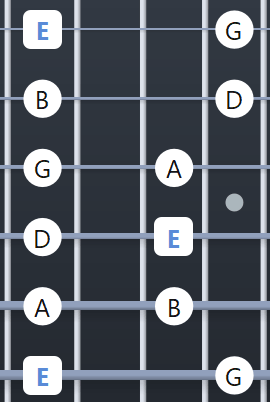
If you look closely, you’ll see that the solo follows the notes in this diagram perfectly. Even the 10th fret at the end is the same note as the 15th fret on the low E string.
The above diagram shows the E minor Pentatonic Scale. If you were to look at the entire guitar solo, you would see that it perfectly matches this scale.
Once you learn the Pentatonic Scale, you will see it everywhere in guitar licks, solos, and riffs. The Pentatonic Scale is the most heavily used scale with guitarists, so it’s worth learning.
Let’s have a quick look at some basic theory behind the scale, then move on to memorizing the scale shapes.
Pentatonic Scale Formula
Understanding the formula the Pentatonic scale is based on can help you better understand the scales and how to use them. Read this guide on intervals if you get stuck reading the below formulas.
Minor Pentatonic Scale Formula
The Minor Pentatonic Scale is built using the formula: 1 b3 4 5 b7
You can see that the Minor Pentatonic scale uses the intervals: root, minor third, perfect fourth, perfect fifth, and minor seventh.
The minor third and minor seventh intervals are what makes this scale a minor scale.
Here’s an example of how to build the Minor Pentatonic Scale using the above formula:

You can see in the above example that if we start with the C Major Scale notes, we can get the C Minor Pentatonic Scale by taking the 1, 3, 4, 5, 7 notes, then lowering the 3 and 7 notes by a half-step (one fret on guitar).
So the C Minor Pentatonic Scale uses the notes: C Eb F G Bb.
You can use the formula to find any Minor Pentatonic Scale by starting with any Major scale notes. Read this guide on Guitar Scales to learn how to find the notes in any Major scale.
Major Pentatonic Scale Formula
The Major Pentatonic Scale is built using the formula: 1 2 3 5 6
You can see that the Major Pentatonic scale uses the intervals: root, major second, major third, perfect fifth, and major sixth.
The major third and major sixth intervals are what makes this scale a Major scale.
Here’s an example of how to build the Major Pentatonic Scale using the above formula:
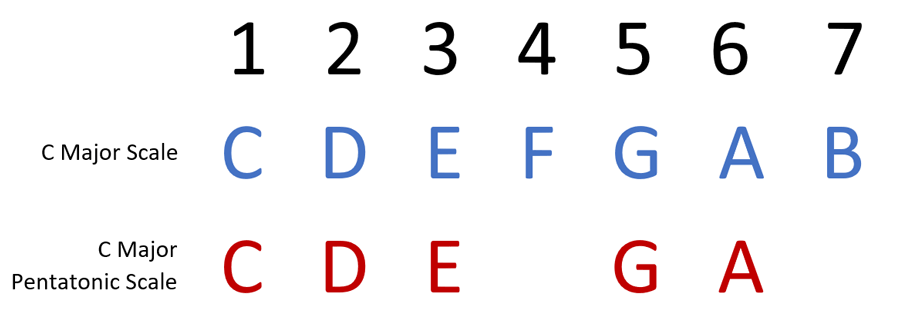
You can see in the above example that if we start with the C Major scale notes, we can get the C Major Pentatonic Scale by taking the 1, 2, 3, 5, 6 notes. Unlike the Minor Pentatonic Scale, you don’t need to raise or lower any intervals to make the Major Pentatonic Scale.
So the C Major Pentatonic Scale uses the notes: C D E G A.
If you practice this a few times using different Major Scales, you will get the hang of it.
Minor Pentatonic Scale Positions
While you can learn the Pentatonic scale by memorizing note positions as explained in this guide, most guitarists learn the Pentatonic scale by breaking it down into five shapes.
The idea is that it’s faster and easier to memorize these five shapes, then you simply connect the shapes together on your fretboard. Once you memorize all five shapes, you’ll be able to play the Pentatonic scale across the entire fretboard.
Let’s walk through the five shapes and some important details about each one.
Position 1
The first position for the Minor Pentatonic Scale is known as the ‘box shape’ due to the almost perfectly square shape it makes across the fretboard.

This is a great starting point if you want to learn the Pentatonic Scale because it’s quick and easy to memorize and you’ll be able to start using it straight away for jamming and improvising.
The square note positions in these diagrams are the root note positions.
It is crucial that you take the time to memorize the root note positions when learning the Pentatonic scale.
Knowing where the root notes are at all times gives you better control over the scale. The most important root note position to remember in this box shape is the root note on the sixth string.
If you want to play any Minor Pentatonic Scale, all you need to do is match the root note position with the scale you want to play.
So if you want to play the A Minor Pentatonic Scale, you would start this box position on the 5th fret because the 5th fret on the 6th string is A.
If you want to play the D Minor Pentatonic Scale, you would start this box position on the 10th fret because the 10th fret on the 6th string is D.
If you haven’t memorized the notes on the fretboard yet, read this lesson for two methods to help you memorize the notes.
Position 2
The second position starts where the first position ended (explained in more detail later). Learning this position after you memorize the first shape is easy as you’ll already feel comfortable with half of the note positions.
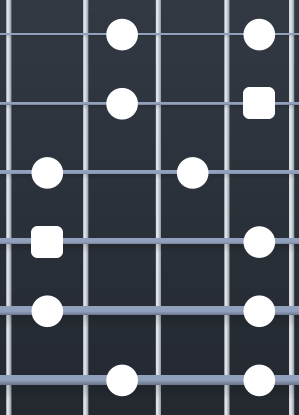
When you learn this shape, don’t forget to pay extra attention to the root note positions. As you play up and down the scale, mentally take note of the root notes as you play them, or you can say something out loud like ‘root note’. It might feel silly to say this out loud, but it will reinforce your memory.
Position 3
This shape starts where position 2 ended. If you have memorized shapes one and two, you should feel confident by now on how to learn these shapes and feel comfortable with them.
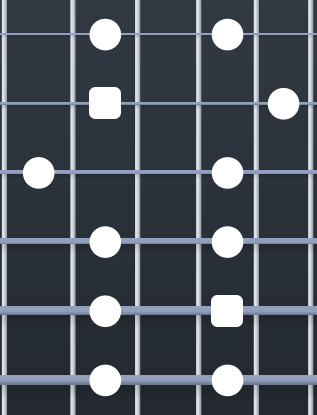
While there is no rule on which fingers you should use to play these shapes, some finger combinations make more sense than others.
For this shape, you will likely want to play the lower three strings using your first and third fingers (index and middle fingers), then use your first and fourth fingers for the G and B strings.
Play around with different finger combinations to make sure you can move around the scale any way you want.
Position 4
Position 4 starts where position 3 ends. This position is a great way to spend some time working on using your fourth finger.
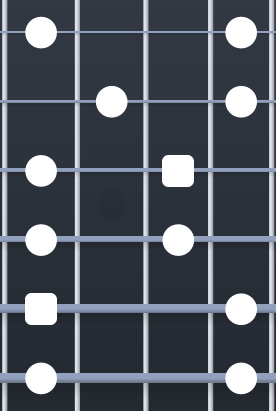
After you memorize the fifth position, spend some time going back and forth between the fourth and fifth positions. Learning to move back and forth between the different positions seamlessly will help you feel more comfortable playing across the entire fretboard.
Position 5
This is the last position to learn and it starts where position 4 ends. It also connects back up to position 1, so you can choose to learn this position last, or any time after you learn position 1.

I suggest learning this position soon after you learn position one so you can move to lower notes from the first position. A lot of guitarists tend to start jamming in position one, then move up the fretboard. Learning position 5 will help you feel comfortable moving lower down the fretboard.
All Positions
If the five positions covered above seem confusing, take some time studying the below fretboard diagram to see how they connect together.

Here are the color codes for the five positions:
- Position 1: Red
- Position 2: Yellow
- Position 3: Green
- Position 4: Blue
- Position 5: Pink
Notice that the positions keep linking together all the way up the fretboard. This is why you’ll be able to play across the entire fretboard after you learn all five positions.
The higher notes in the first position are the starting notes of the second position. Each position connects to the previous one, which is why this is a very popular way of memorizing the scale.
Take a look at the above fretboard diagram and work out what the root note is. The root note determines what Pentatonic scale you are playing, so it’s important that you learn to identify the root notes for any scale.
The above diagram shows the A Minor Pentatonic Scale. If you look at the root note positions, you might notice that each position uses the note ‘A’. For example, notice that the open A string is highlighted as a root note.
With the above information, try to figure out how you would play the five positions to play the B Minor Pentatonic or the D Minor Pentatonic.
Practice finding different Pentatonic Scales by moving the shapes up and down the fretboard.
Major Pentatonic Scale Positions
You might be surprised to hear that the five positions in the Major Pentatonic Scale are identical to the five positions in the minor Pentatonic Scale. The numbering of the positions changes, but they’re the same shapes.
This means once you memorize the five positions covered above, you will also know how to play the Major Pentatonic Scale.
The main difference between the two scales you need to keep in mind is that the root note positions change. This will make sense after you look through the below shapes.
Position 1
The first position in the Major Pentatonic Scale uses the same shape as position 2 in the minor Pentatonic Scale.
In the below diagram, take note of the square shapes, which represent the root note of the scale.
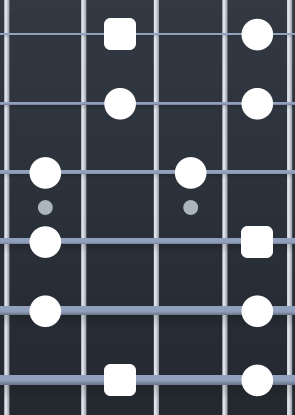
If you compare the above shape with the Minor Pentatonic Scale, you’ll see that while the shape is the same as position 2 in the minor Pentatonic Scale, the root note positions change.
Position 2
With this position, think about which finger positions make the most sense as you move up and down the notes.
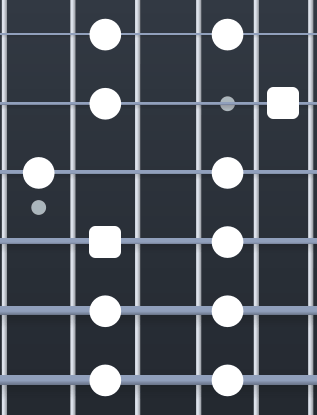

For example, you could play this entire position using only your first and third fingers. Try playing up and down the scale using those fingers and see how it feels.
Then try it again using your fourth finger in any position where you need to stretch further.
There’s no rule on which fingers you should use, so try a few different combinations and see what feels best to you.
Position 3
Position 3 of the Major Pentatonic Scale should feel very familiar if you have spent time memorizing the minor Pentatonic Scale. You should feel comfortable choosing which fingers to use as you move through the strings.
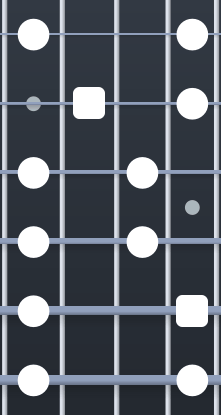

Remember to pay extra attention to the root note positions as it’s important to always know where they are.
Position 4
Try using your first and fourth fingers on the D and G strings, then use your second and fourth fingers on the other strings. See how that feels and think about if there are any other finger combinations that might feel better.


Position 5
The final position of the Major Pentatonic Scale should look very familiar to you if you have started learning the minor Pentatonic Scale. It’s the same shape as the first position in the minor Pentatonic Scale.
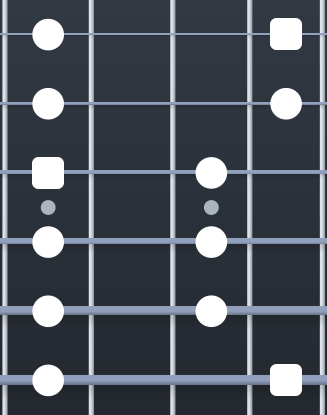

It’s important to understand how the Major and minor Pentatonic Scales are related so you can easily switch between them when you need to.
All Positions
Here are the five positions of the Major Pentatonic scale on a fretboard diagram:


Here are the color codes for the five positions:
- Position 1: Yellow
- Position 2: Green
- Position 3: Blue
- Position 4: Pink
- Position 5: Red
If you compare this diagram to the earlier diagram of the minor Pentatonic Scale, it will make it clear how closely related the two scales are.
Both scales use the same shapes, but each scale starts on different root notes.
In the earlier example of the minor Pentatonic Scale, we were looking at the A minor Pentatonic Scale. The above diagram shows the C Major Pentatonic Scale.
Both of these scales use the same notes and the same shapes, but they start on different root notes.
Switching Between Major and minor Pentatonic Scales
Here’s an easy way to switch back and forth between the Major and minor Pentatonic Scales while using the same shapes.
Look at the first position of this minor Pentatonic Scale:


In the above diagram, you can see that the root note for the minor Pentatonic Scale is A on the fifth fret. This means we are using the A minor Pentatonic Scale.
If you look at the next note up in this position (the 8th fret), you can see it is C. This gives us the root note for the relative Major Pentatonic Scale.
So you can use the same shapes and positions for either the A minor Pentatonic Scale (fifth fret root note) or the C Major Pentatonic Scale (eighth fret root note).
Here’s another example starting on the 10th fret:


What would be the minor and Major Pentatonic Scales based on this position?
The first note position tells you the minor Pentatonic Scale, so this gives you the D minor Pentatonic Scale. The next note up in the position (three frets higher) tells you the Major Pentatonic Scale, so this gives you the F Major Pentatonic Scale.
This means both the D minor Pentatonic Scale and the F Major Pentatonic Scale use the same shapes and positions.
The key point to remember is that you can find the Major Pentatonic Scale root note by moving three frets up from the minor Pentatonic Scale root note.
If you practice this a few times, it will start to make sense and you’ll be able to use it to quickly jump back and forth between minor and Major Pentatonic Scales.
Songs Using the Pentatonic Scale
The Pentatonic Scale is used in a wide range of music styles and many guitarists write most of their solos or lead parts using it.
Once you learn how to recognize the Pentatonic Scale in music, you will see and hear it everywhere. Some music styles such as rock and blues tend to focus on the Pentatonic Scale more than other styles, but it will still show up everywhere.
Here are some classic rock songs that heavily use the Pentatonic Scale:
- Back In Black by AC DC
- All Along the Watchtower by Jimi Hendrix
- Stairway to Heaven by Led Zeppelin
- Another Brick in the Wall (Part 2) by Pink Floyd
- Paradise City by Guns N’ Roses
- Enter Sandman by Metallica
Check out some of the above songs and try to figure out what Pentatonic Scale is used (eg: E Minor Pentatonic, C Major Pentatonic, etc.).
Some guitarists use the Pentatonic Scale as their go-to scale for solos, so if you find a song that heavily uses it, check out other songs by that same guitarist. You’ll likely find plenty of other examples of the scale in use.
You may notice that the above songs all use the minor Pentatonic Scale. The minor Pentatonic Scale tends to be the far more commonly used scale because music in classic rock and similar styles tend to be written in minor. You will find songs that use the Major Pentatonic Scale, but the minor Pentatonic Scale is far more popular.
Pentatonic Scale Exercises
Before you can start using the Pentatonic Scale to write your own solos, jam with other guitarists, or learn songs that use the scale, spend some time practicing the scales.
The more you practice changing back and forth between different Pentatonic Scale positions, the easier it will be when you want to learn a song that uses that scale.
Here are two different ways you can start practicing the Pentatonic Scale.
Memorizing the Notes
A simple way to get started memorizing the notes in the Pentatonic Scale is to simply run up and down each of the five positions.
This is how most guitarists start learning the scale because it’s easy to practice and doesn’t take long for you to memorize each shape.
For example, the below exercise is what you could play to start memorizing the first position of the minor Pentatonic Scale:


You simply walk up the scale one note at a time, then you would move back until you reach the starting position.
The advantage of practicing this way is that it allows you to think about which fingers you should use in each position. It’s a simple exercise, so you can take your time making sure you use the best finger combinations possible.
While simple exercises like the above example are a good starting point, don’t rely on them too much.
I explain in detail How to Practice Guitar Scales in this guide. The guide talks about exercises like the above example as well as how to incorporate exercises into a practice routine.
If you want to properly memorize the Pentatonic Scale, read the guide and follow the advice.
Jamming Exercises
One of the easiest ways you can start using the Pentatonic Scale is to learn to jam with it over a backing track.
Loading up a backing track on YouTube and playing around with the matching Pentatonic Scale is a lot of fun and teaches you how to use the scale.
Check out this basic lesson on improvising if you have never tried improvising before.
As a simple exercise to get you started, try jamming with the below blues backing track using the A minor Pentatonic Scale. You can use any of the five positions, or you can play all over the fretboard – it’s up to you.
Here is the diagram for the A minor Pentatonic Scale to help you find the note positions:



Start out in any position you feel comfortable and just get used to playing the correct notes along with the backing track.
As you begin to feel more confident, you can move around the fretboard, add in techniques such as bends and slides, and try coming up with interesting licks.
This is a fantastic way to practice the Pentatonic Scale, so spend some time every day jamming along with different backing tracks.
Simply search YouTube for “A minor backing track”, “D minor blues backing track”, “E minor rock backing track” or any other key or style you like.
Pentatonic Scale Tips
Here are a few extra tips to help you get started using the Pentatonic Scale.
Learn All Five Positions
To be able to play across the entire fretboard, you need to learn all five positions and practice moving back and forth between the positions.
Some guitarists stop after learning the first position. If you only know one or two positions, you’re going to get stuck in a rut. Take the time and effort to learn all five positions and practice moving through all of them. It’s worth the effort.
Jam in Different Keys
If you only jam in one or two keys, you’ll eventually get stuck in a rut. Learning to shift (transpose) the Pentatonic Scale to match different keys is an important skill to learn.
Look up jam tracks on YouTube in different keys (eg: ‘C Major Blues Backing Track’, ‘D Minor Rock Backing Track’, etc.) and practice using the Pentatonic Scale in as many different keys as you can.
Once you feel comfortable figuring out the positions for any key, you’ll feel far more confident in using the Pentatonic Scale when you jam with other musicians.
Play Some Passing Notes
There are a lot of notes that the Pentatonic Scale skips. Some of these notes you might want to add in to your playing. Some of the notes outside of the Pentatonic Scale may not sound right when you play them, but every note can be used in some way or another.
Try throwing in a few notes from outside of the Pentatonic Scale and see if you can get those notes to sound good.
For a good example of how adding in a passing note can add something interesting to your playing, check out the Blues Scale. The Blues Scale adds in one extra note on top of the Minor Pentatonic Scale. That extra note is a great example of how to use passing notes.
Learn about the Blues Scale in this guide.
Learn Other Scales (When You’re Ready)
While the Pentatonic Scale is incredibly fun to use and versatile, it’s only one type of scale you can use. If you only learn the Pentatonic Scale and nothing else, you’re going to be limited in the type of music you can play.
After you feel comfortable with the Pentatonic Scale, try learning some other scales to broaden your horizons. Every different type of scale you learn gives you a new way to play music and you’ll find that each scale changes the way you play.
The next scales you might want to learn are the Blues Scale and the Major Scale. From there you can check out modes or look at other types of scales such as the Harmonic Minor Scale.
Check out this guide on what guitar scales you should learn for more details.
Take It Easy On Technical Exercises
If you look up any lesson on the Pentatonic Scale, you’ll likely get a list of exercises to help you memorize the scale positions. While scales exercises are helpful, be careful not to focus on them for too long.
Spending too much time on scales exercises trains you to think about the scale like an exercise. If you run up and down scales exercises every day, don’t be surprised if that’s the only thing you can do with the scale after a while.
Use scales exercises to help you memorize the positions and shapes, then move on to using the scale in a musical way. Try not to focus on the technical side of scales and spend more time thinking about how to make music using scales.
Pentatonic Scale FAQ
Have a question about the Pentatonic Scale not covered in this guide? Does something not quite make sense? Let me know here so I can improve this guide.
Here are some common questions you might have about the Pentatonic scale:
Why is the Pentatonic Scale so Popular?
The Pentatonic Scale is so popular with guitarists because it’s easy to learn and sounds great in a wide range of music styles. Each of the five notes in the Pentatonic scale works extremely well together and make it easy to create interesting melodies and parts.
Should I Learn Minor or Major Pentatonic?
You can learn either the Minor or Major Pentatonic Scale because both scales are closely tied together. For every Minor Pentatonic Scale, there is a Major Pentatonic Scale that uses the exact same notes. For example, the C Major Pentatonic and A Minor Pentatonic Scales use the exact same notes. So you can learn either one and learn to use the scales in different situations.
What Pentatonic Scales Should I Learn First?
The Minor Pentatonic Scale should be the first you learn because it uses an easy pattern or shape to help you memorize the first position. The first position of the Minor Pentatonic Scale is known as the ‘box’ shape, because of the basic box shape it makes on the fretboard. This shape is an easy way to start learning the scale and start using it.
How Many Pentatonic Scales Are There?
There is a Major Pentatonic Scale and a Minor Pentatonic Scale for every note pitch. There are 12 note pitches in western music, so there are 12 possible Major Pentatonic Scales and 12 possible Minor Pentatonic Scales.
What Scale Should I Learn After the Pentatonic?
After learning the Pentatonic Scale, you might want to learn the Blues Scale or the Major Scale next. The Blues Scale is easy to learn because it adds in one extra note compared to the Minor Pentatonic Scale, so it is easy to learn. The Major scale is an important scale to learn and worth memorizing.
Learn to play the Blues Scale in this guide.
A lot of guitarists get stuck after learning the Pentatonic Scale. Read this guide on how to break out of the Pentatonic box to avoid it happening to you.
Here are some more resources and guides on guitar scales:
- How to Practice Guitar Scales: Exercises, Charts, PDFs
- Guitar Scales Explained Simple
- How to Get Better at Guitar Scales
- What Guitar Scales and Modes Should You Learn?
- How to Memorize the Fretboard
